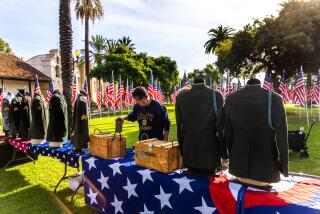Blue Star Flags Keep Service Members Close
- Share via
It’s been months since Pat and Diane Tregarthen took down the red, white and blue decorations from their Redondo Beach home. But two paper flags remain.
The flags, printed off the Internet on 8 1/2-by-11-inch paper, are taped to a window by the front door. Each has a blue five-point star at the center of a white field and a thick red border.
Popular during the World Wars, they are known as blue star service flags. They let passersby know the family has someone in the military.
One flag was for their son, Mark, the other for their daughter-in-law, Jennifer. The couple served in Iraq for much of 2003 and returned to their Texas home six months ago.
But still, the Tregarthens keep the flags displayed, along with a “Support Our Troops” cardboard sign stuck in a hedge. They want to remind the neighborhood that there are still young men and women in combat.
“At the beginning, there were so many flags, but over time, it disappears,” said Diane Tregarthen. “It’s a good reminder that the troops are still out there, and they still need us.”
Blue star service flags, traditionally replaced by a gold star if the serviceman or woman dies, are making a comeback among military families, and cities are embracing the tradition to show community support for those in the military.
“They’re doing the same thing now as they did in World War II,” said Ray Molina, commander of the Veterans of Foreign Wars post in Redondo Beach. “The significance was to show they were very proud of their sons and daughters overseas.”
Sales have grown steadily at Service Flags, one of the largest online sellers of military paraphernalia.
“We’ve seen an increase in the last few months, especially with the gold star, which is pretty sad,” said Diana Smith, a spokeswoman for the company, based in Carson City, Nev.
The company donates gold star flags to families of slain soldiers.
In January 2002, Monrovia became one of the first cities in Southern California to adopt a blue star service flag program, which includes letter writing between troops and its school district’s fourth-graders, and a twice-monthly support group for military families.
Later that year, the city began displaying flags with names of service members along Huntington Drive. Today, more than 155 blue star service flags fly over a three-mile stretch of the city’s main thoroughfare.
“There is no politics to this at all; it doesn’t say Republican or Democrat,” Monrovia Mayor Rob Hammond said. “This is about supporting the people who are giving us the freedoms that we enjoy.”
City councils in West Covina, Sierra Madre, Arcadia and San Dimas have adopted similar service flag programs.
In Sacramento, Assemblyman George Nakano (D-Torrance) sponsored a resolution last year that designates California Highway 1 as Blue Star Memorial Highway. Legislators unanimously approved the measure in July.
On March 20, the first Blue Star Memorial Highway marker along Pacific Coast Highway was installed in Redondo Beach. The military-green cast aluminum sign, donated at a cost of about $1,000 per marker, is one of 53 Blue Star Memorial Highway signs throughout the state.
“In Torrance, we have an armed forces parade that only happens once a year, but this sign is there all year,” Nakano said. “It’s part of an educational process to remind people of why it’s important to remember.”
The flags were designed and patented by a World War I Army captain in 1917. Theodore Roosevelt’s son, who was shot down over France during the war, had a gold star flag hung in his honor.
Their popularity peaked during World War II, when mothers across the country hand-sewed and displayed half a million blue and gold star service flags.
But they virtually disappeared during the Vietnam War. Anti-war demonstrators targeted homes with service flags.
Today, in a wave of support for troops, blue star flags are seeing a resurgence, military families say.
The Tregarthens, who live less than a mile from the highway marker, said they would not mind keeping their display of flag printouts and their sign.
“It’s the only way we can think of to let them know support is coming from their community,” Diane Tregarthen said.
More to Read
Sign up for Essential California
The most important California stories and recommendations in your inbox every morning.
You may occasionally receive promotional content from the Los Angeles Times.













